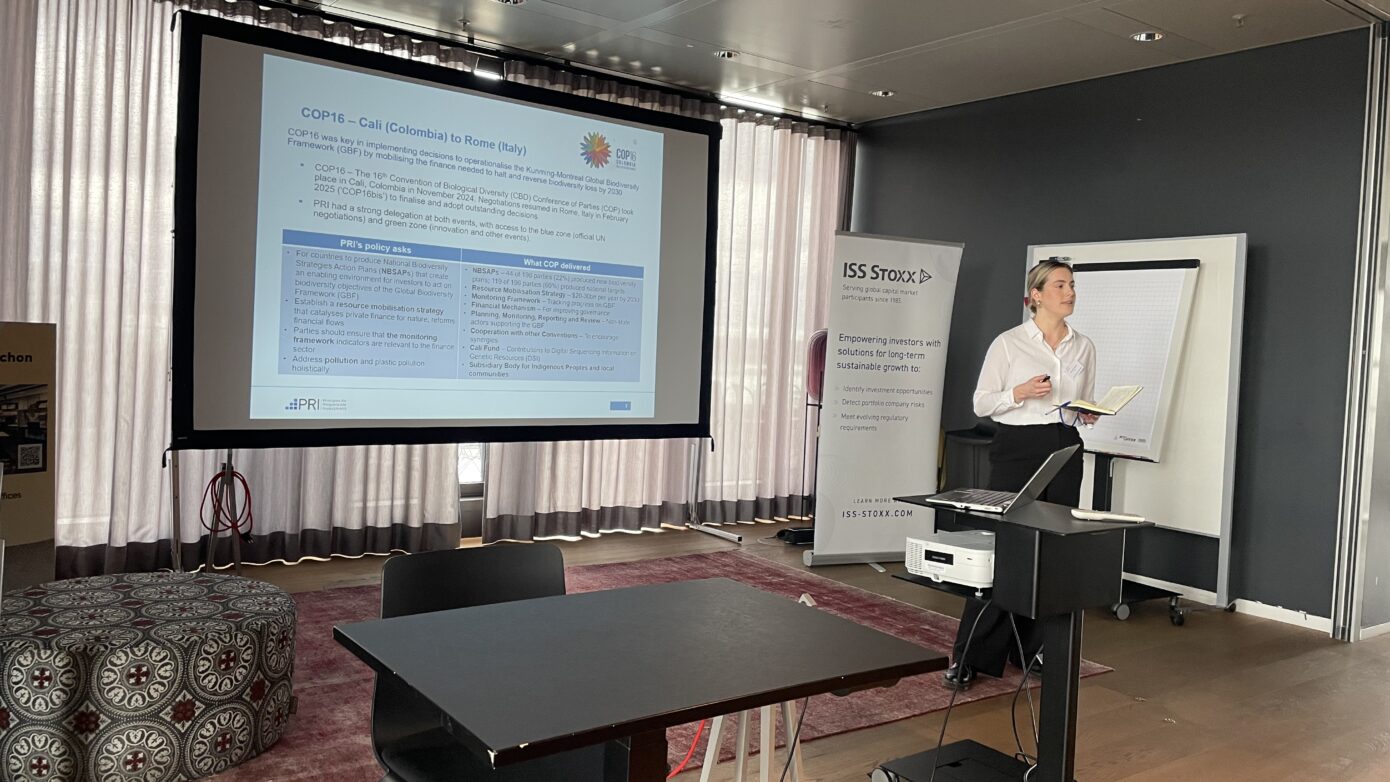The topic of biodiversity is rapidly becoming more and more recognized as a material issue among sustainable investors. Why is biodiversity gaining so much attention in the last years? Our economy heavily depends on biodiversity and ecosystem services, with more than half of the world output being dependent on nature.
According to the latest WWF Living Planet Report 73% of species have already been lost since 1970. The biodiversity crisis we are facing right now impose significant risks for the companies and economies that are financially material. Furthermore, the urgent need for biodiversity protection and restoration in order to achieve global biodiversity goals reveals enormous investment opportunities.
For us as asset managers, integrating biodiversity into our investment practices allows us
- to contribute to protecting our nature and achieving the world’s biodiversity goals, and
- to enable long-term value for our investors.
PRI Nature Forum: Discussing the topic of biodiversity
Acting alone on this complex field would be difficult and frustrating. Luckily, there exists a large community of sustainable investors, who strive to achieve the same goals and are willing to support each other on the way towards them. End of March, Erste Asset Management was invited to the PRI Nature Forum, which took place in Munich and was hosted by our partners from ISS ESG. I was honored to represent EAM at this event and found myself among the most enthusiastic and motivated people with similar passion – finding solutions for nature and biodiversity.
All of us shared similar interests and many of us turned out to be facing similar struggles: how to integrate biodiversity into our investment practices in the best way? Is it possible to quantify biodiversity? Should we use footprints metrics or develop own biodiversity scores? We could discuss these and many further questions, as well as share highlights of our practices and approaches with each other.

The event has started with a session of insightful presentations by PRI, ISS and other participants. Here are some interesting take-aways I brought home with me:
- Biodiversity and Climate are closely interconnected and should not be treated separately! Climate goals will not be achieved without conservation and restoration of biodiversity. Biodiversity crisis will not be stopped without tackling climate change. Despite the split of the scientific community in “climate” and “biodiversity” groups, as well as the lack of cooperation between of IPCC and IPBES (respective intergovernmental panels), the most effective way to protect our environment is to consider both together.
- Biodiversity includes genetic, species and ecosystem diversity. Biodiversity is not only about the abundance of species. Genetic, species and ecosystem diversity are equally important! The loss of genetic diversity threatens species ability to survive and adapt. Intact ecosystems are essential for species life, including provision of habitats, nutrient cycles, etc. Finally, when we talk about species diversity – the extinction or over-spreading of any small organism can bring the nature out of balance.
- It makes sense to focus on financing activities that prevent harm to nature and biodiversity. As an example, in 2018 Germany has spent around 65 bn € on subsidies damaging the environment (Umweltbundesamt). In the same year, Germany spent around 74 bn € environmental protection and removal of environmental damages – which is very economically inefficient (Statistisches Bundesamt). Instead of first financing harmful activities and then investing into mitigation of harm, we should rather think of preventing harm at the first place. Off-setting is the worst for nature, although it is a very popular investment opportunity.
- ENCORE can be very helpful for identifying industry-specific dependencies and impacts on nature. This UN-backed online tool provides investors with an opportunity to explore industry-level risk materialities & can be used for various purposes, such as, primary identification of high-risk sectors for engagement focus or assessing portfolios’ exposure to nature risks.
- Still, one of the main challenges so far is – making the topic of Biodiversity mainstream. While the topic of climate change is widely recognized, many players in the financial sector still do not consider the topic to be enough financially material to integrate it into their decision making, investment and ownership practices. It is essential to facilitating further research and knowledge exchange to motivate more and more investors to act and make positive change.
Note: Please note that an investment in securities entails risks in addition to the opportunities described.
Already on a good track
The presentation session has turned out to be very interactive – many guests representing asset management firms, insurance companies and other stakeholders took part in discussions and shared their knowledge, thoughts, and struggles. Among topics discussed were, the use of biodiversity footprint metrics, such as MSA and PFD, their strengths and weaknesses. Some of the guests have mentioned that instead they have decided for developing own biodiversity scores. We broadly agreed on the importance of focusing on IPBES science-based pressures on biodiversity, which include climate change, ecosystem use change, resource use, pollution and invasive species, considering differences among geographies and industries and incorporating companies’ supply chains.
In the discussions it turned out that Erste Asset Management has already achieved a considerable progress towards integration of this complicated topic in our investment framework. By having a Biodiversity Policy, actively engaging with companies on biodiversity issues, including being members of the PRI Spring initiative, as well as by having initiated thematic research and the development of an in-house Biodiversity Score – we have positioned ourselves among best-practitioners, according to PRI.
Conclusion
Of course, there is still a long way of improvement in front of us in terms of integrating biodiversity into our investment practices. That is why we are motivated to join the events such as this one, to exchange the knowledge and experience with this complex topic and learn from the pioneers on this arena. Here an overview of our next steps on the topic of biodiversity just to give you a hint on where we as asset manager want to develop 👉
Roadmap for our Biodiversity Action:
- Update our Biodiversity Policy end of this year
- Facilitate our qualitative and quantitative research on the topic.
- Accelerate knowledge through exchange with partners and other asset managers.
- Further integrate the topic in our investment practice through developing the biodiversity score and looking specifically at sub-topics, such as water use, etc.
- Enhance the engagement with companies directly and through different collaborative channels, including PRI Spring.
Legal disclaimer
This document is an advertisement. Unless indicated otherwise, source: Erste Asset Management GmbH. The language of communication of the sales offices is German and the languages of communication of the Management Company also include English.
The prospectus for UCITS funds (including any amendments) is prepared and published in accordance with the provisions of the InvFG 2011 as amended. Information for Investors pursuant to § 21 AIFMG is prepared for the alternative investment funds (AIF) administered by Erste Asset Management GmbH pursuant to the provisions of the AIFMG in conjunction with the InvFG 2011.
The currently valid versions of the prospectus, the Information for Investors pursuant to § 21 AIFMG, and the key information document can be found on the website www.erste-am.com under “Mandatory publications” and can be obtained free of charge by interested investors at the offices of the Management Company and at the offices of the depositary bank. The exact date of the most recent publication of the prospectus, the languages in which the fund prospectus or the Information for Investors pursuant to Art 21 AIFMG and the key information document are available, and any other locations where the documents can be obtained are indicated on the website www.erste-am.com. A summary of the investor rights is available in German and English on the website www.erste-am.com/investor-rights and can also be obtained from the Management Company.
The Management Company can decide to suspend the provisions it has taken for the sale of unit certificates in other countries in accordance with the regulatory requirements.
Note: You are about to purchase a product that may be difficult to understand. We recommend that you read the indicated fund documents before making an investment decision. In addition to the locations listed above, you can obtain these documents free of charge at the offices of the referring Sparkassen bank and the offices of Erste Bank der oesterreichischen Sparkassen AG. You can also access these documents electronically at www.erste-am.com.
Our analyses and conclusions are general in nature and do not take into account the individual characteristics of our investors in terms of earnings, taxation, experience and knowledge, investment objective, financial position, capacity for loss, and risk tolerance. Past performance is not a reliable indicator of the future performance of a fund.
Please note: Investments in securities entail risks in addition to the opportunities presented here. The value of units and their earnings can rise and fall. Changes in exchange rates can also have a positive or negative effect on the value of an investment. For this reason, you may receive less than your originally invested amount when you redeem your units. Persons who are interested in purchasing units in investment funds are advised to read the current fund prospectus(es) and the Information for Investors pursuant to § 21 AIFMG, especially the risk notices they contain, before making an investment decision. If the fund currency is different than the investor’s home currency, changes in the relevant exchange rate can positively or negatively influence the value of the investment and the amount of the costs associated with the fund in the home currency.
We are not permitted to directly or indirectly offer, sell, transfer, or deliver this financial product to natural or legal persons whose place of residence or domicile is located in a country where this is legally prohibited. In this case, we may not provide any product information, either.
Please consult the corresponding information in the fund prospectus and the Information for Investors pursuant to § 21 AIFMG for restrictions on the sale of the fund to American or Russian citizens.
It is expressly noted that this communication does not provide any investment recommendations, but only expresses our current market assessment. Thus, this communication is not a substitute for investment advice.
This document does not represent a sales activity of the Management Company and therefore may not be construed as an offer for the purchase or sale of financial or investment instruments.
Erste Asset Management GmbH is affiliated with the Erste Bank and austrian Sparkassen banks.
Please also read the “Information about us and our securities services” published by your bank.

